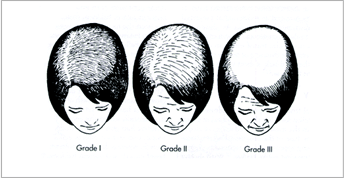Female Hair Loss FAQ
Understanding Women’s Hair Loss and What Can Be Done About It
The most common type of hair loss seen in women is androgenetic alopecia, also known as female pattern alopecia or baldness and alopecia areata. Androgenetic alopecia was only partially understood until the last few decades. For many years, scientists thought that androgenetic alopecia was caused by the predominance of the male sex hormone, testosterone, which women also have in trace amounts under normal conditions. While testosterone is at the core of the balding process, DHT is thought to be the main culprit.
The hormonal process of testosterone converting to DHT, which then harms hair follicles, happens in both men and women. Under normal conditions, women have a minute fraction of the level of testosterone that men have, but even a lower level can cause DHT- triggered hair loss in women. And certainly, when those levels rise, DHT is even more of a problem. Those levels can rise and still be within what doctors consider “normal” on a blood test, even though they are high enough to cause a problem. The levels may not rise at all and still be a problem if you have the kind of body chemistry that is overly sensitive to even its regular levels of chemicals, including hormones.
Related: Who Do Women Experience Thinning Hair & Hair Loss?
Hair loss in women isn’t always as straightforward as it is in most men. In men about 90 percent of all cases are caused by hereditary male pattern baldness. In women, however, hair loss can be triggered by a multitude of conditions and circumstances.

Common Causes of Hair Loss in Women
- Andogenetic Alopecia: Can be caused by a variety of factors tied to the actions of hormones, including, ovarian cysts, the taking of high androgen index birth control pills, pregnancy, and menopause.
- Alopecia Totalis: Total hair loss of the scalp, (an advanced form of alopecia areata).
- Alopecia Universalis: Hair loss of the entire body, (also an advanced form of alopecia areata).
- Traction Alopecia: Hair loss caused by physical stress and tension on the hair such as prolonged use of hair weaving, corn rows etc.
- Telogen Effiuvium: Hair loss Caused by Physical stress, emotional stress, thyroid abnormalities, medications and hormonal causes normally associated with females.
- Anagen Effiuvium: Generally due to internally administered medications, such as chemotherapy agents, that poison the growing hair follicle.
- Trichotillomania: (TTM), or “trich” as it is commonly known, is an impulse control disorder characterized by the repeated urge to pull out scalp hair, eyelashes, facial hair, nose hair, eyebrows or other body hair, often resulting in noticeable bald patches.
- Chemotherapy: One of the most common side effects of chemotherapy treatment is hair loss. Chemotherapy hair loss may occur on the scalp, face, underarms, and other places on the body.
Hair Loss Solutions in the Quad Cities
Hair replacement systems have revolutionized the way individuals with hair loss can regain their confidence and achieve a natural-looking appearance. With their customizable nature, long-lasting durability, and versatility in styling, these systems provide an effective solution for both men and women experiencing hair loss. If you are considering non-surgical hair replacement system, we invite you to schedule a free, private consultation at Transitions in Moline today. We will answer all your questions and help you find the best solution for your needs. Remember, regaining your hair means regaining your confidence and embracing your true self.
